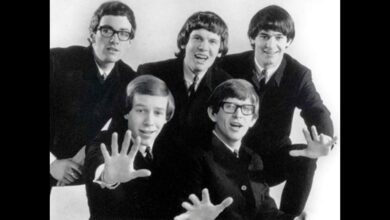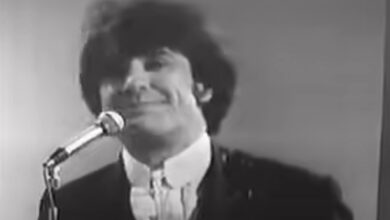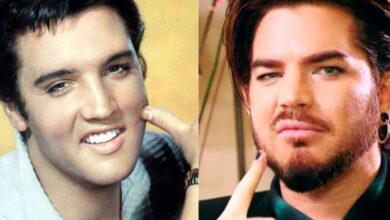Donovan’s “Sunshine Superman” – The Psychedelic Anthem That Redefined 1966
When “Sunshine Superman” was released in 1966, it became a groundbreaking moment in popular music, marking the arrival of psychedelia as a mainstream force. With its hypnotic blend of folk, jazz, and electric rock, the song captured the spirit of the emerging counterculture and pushed musical boundaries in a way that few had before. The track reached No. 1 on the Billboard Hot 100 in the U.S. and No. 2 on the UK Singles Chart, cementing Donovan’s status as a pioneer of the psychedelic movement. More than just a hit, “Sunshine Superman” was a blueprint for the genre, influencing countless artists who would soon follow in its wake.
Donovan, born Donovan Philips Leitch in 1946 in Scotland, emerged as one of the most distinctive voices of the 1960s folk revival. Initially labeled as Britain’s answer to Bob Dylan, he quickly distinguished himself with a more mystical, dreamlike quality in his songwriting. His early work, including “Catch the Wind” and “Colours”, showcased his folk roots, but by 1965, he was eager to explore new sonic landscapes. Inspired by the changing musical landscape and the rise of hallucinogenic culture, Donovan sought to craft a song that blended his folk sensibilities with a more expansive, electric sound—thus, “Sunshine Superman” was born.
The inspiration for “Sunshine Superman” came from a mix of personal and cultural influences. Donovan was deeply in love with his future wife, Linda Lawrence, and the song was partly a tribute to her. But beyond romance, it also reflected his fascination with superheroes, mysticism, and the emerging psychedelic movement. The title itself referenced Superman, an emblem of strength and escapism, while the lyrics played with the idea of transcending reality, making it one of the earliest pop songs to fully embrace psychedelic imagery.
Recording “Sunshine Superman” was a complex process that pushed the boundaries of studio experimentation. The track was produced by Mickie Most, a renowned producer known for working with The Animals and The Yardbirds. The arrangement featured a mix of jazz and rock instrumentation, with John Paul Jones (who would later become a founding member of Led Zeppelin) handling the bass and harpsichord. The use of a sitar, an instrument not yet commonly heard in Western rock, added an exotic and otherworldly quality to the track. Donovan’s smooth, almost hypnotic vocal delivery made it even more immersive, drawing listeners into a colorful, surreal sonic landscape.
Upon its release, “Sunshine Superman” was met with widespread acclaim. It topped the U.S. charts, marking Donovan’s first major breakthrough in America, where he became a favorite of the emerging hippie movement. The song’s success was slightly delayed in the UK due to a contractual dispute, but when it finally hit the British charts, it quickly climbed to No. 2. Critics praised its originality, and fans embraced its innovative sound, helping to establish Donovan as a leading figure in psychedelic music.
Beyond its chart performance, “Sunshine Superman” had a significant cultural impact. Released at the dawn of the psychedelic era, it helped introduce the genre’s defining elements to mainstream audiences. Its dreamy, surreal lyrics and unconventional instrumentation paved the way for later classics like The Beatles’ “Lucy in the Sky with Diamonds” and The Doors’ “The Crystal Ship.” Donovan’s ability to merge folk storytelling with electric experimentation inspired artists across multiple genres, reinforcing the idea that pop music could be both commercially viable and artistically adventurous.
For Donovan himself, “Sunshine Superman” marked a turning point. No longer just a folk troubadour, he had evolved into a fully-fledged pop innovator. The song’s success led to a string of hits, including “Mellow Yellow”, “Hurdy Gurdy Man”, and “Season of the Witch”, each further exploring his psychedelic vision. He quickly became an icon of the late 1960s counterculture, mingling with The Beatles, teaching George Harrison about Eastern spirituality, and becoming a key voice of the era’s artistic revolution.
The song’s influence extended beyond Donovan’s own work. It played a crucial role in shaping the sound of the psychedelic movement, inspiring artists from The Rolling Stones to Jefferson Airplane. The use of exotic instrumentation, layered production, and cryptic, whimsical lyrics became hallmarks of the genre, elements that would define the late 1960s and early 1970s rock landscape.
Over the years, “Sunshine Superman” has been covered by a variety of artists, each bringing their own spin to its unique structure. Acts like Hüsker Dü, Rickie Lee Jones, and Mel Tormé have all recorded versions, proving its versatility across genres. While many artists captured the song’s dreamy essence, few could match the original’s perfect balance of folk intimacy and electric boldness.
At the time of its release, Donovan was at the center of a rapidly shifting cultural and musical landscape. The rise of psychedelia, Eastern philosophy, and artistic experimentation was changing the industry, and “Sunshine Superman” perfectly captured this moment in time. Its success provided a commercial breakthrough for more experimental music, showing that audiences were ready for something beyond traditional pop and rock structures.
Decades later, “Sunshine Superman” remains a defining song of the psychedelic era. It continues to be featured in films, TV shows, and commercials, keeping its legacy alive for new generations. Classic rock and psychedelic playlists still give it regular airplay, ensuring that its influence is never forgotten.
Looking at its broader impact, the song helped bridge the gap between folk and rock, setting the stage for future genre-blending artists. It also proved that pop music could be both introspective and experimental, a lesson that would be embraced by countless artists in the decades that followed.
Even as Donovan’s career evolved, “Sunshine Superman” remained his signature song, the track that defined his artistic breakthrough and cemented his place in music history. It remains a testament to the power of innovation and the spirit of the 1960s—a song that, more than half a century later, still feels as fresh and hypnotic as it did upon its release.



